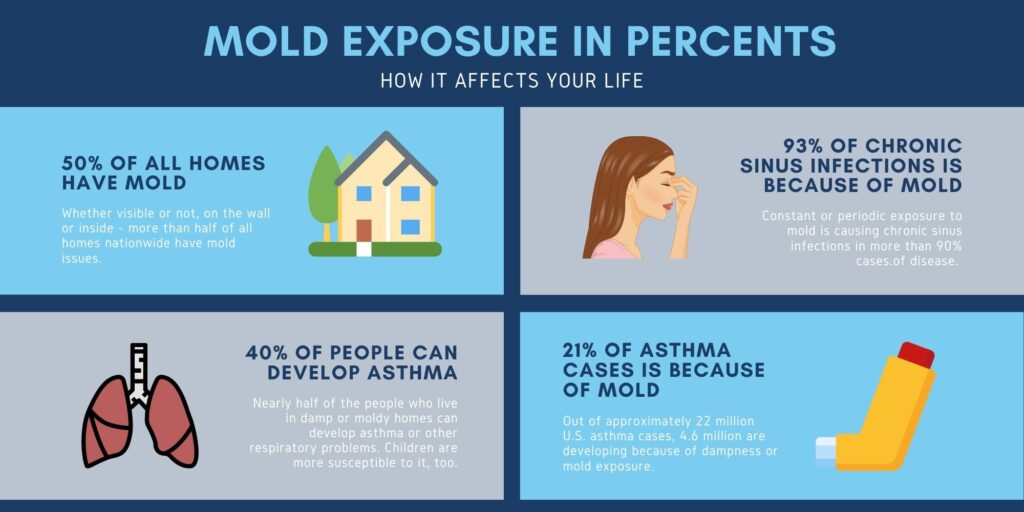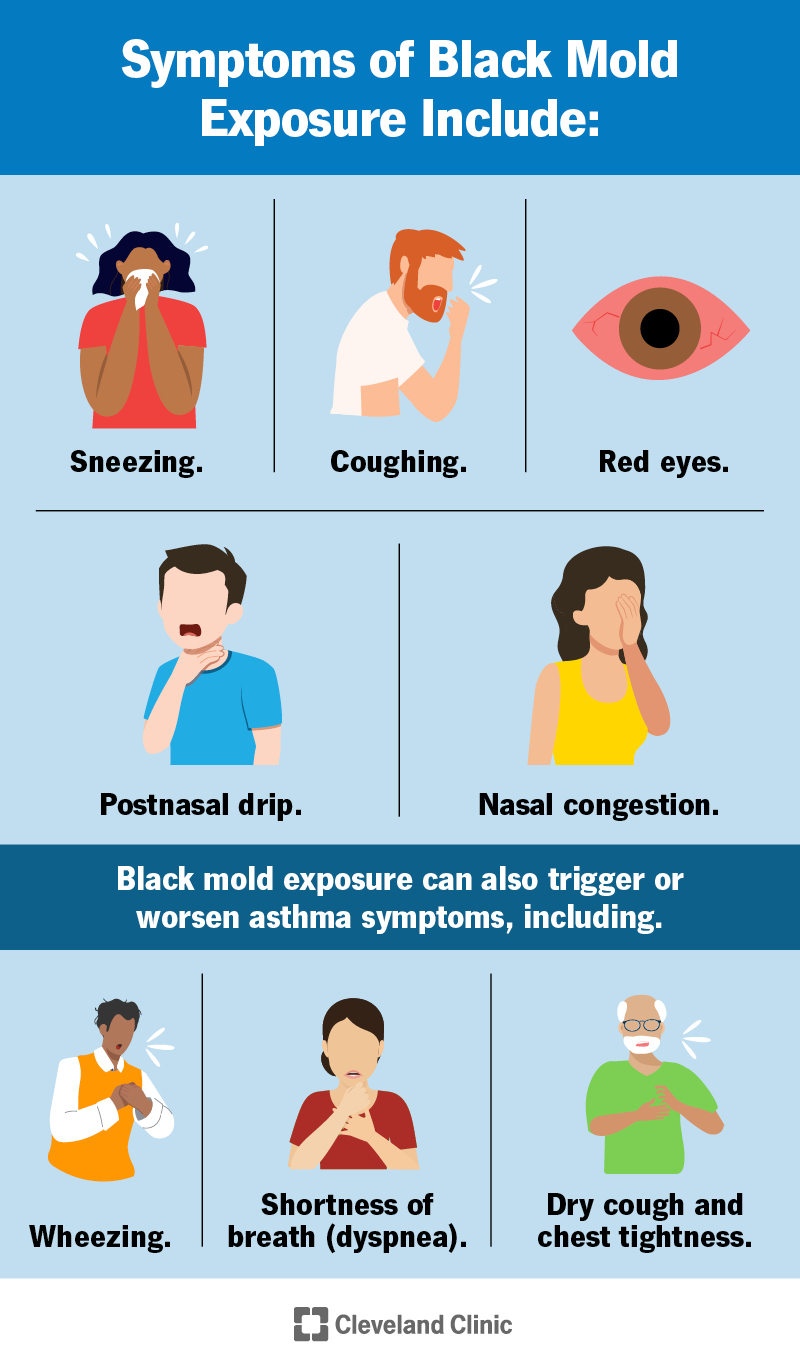Have you ever noticed a musty smell in your home or experienced unexplained allergic reactions? If so, you may be suffering from mold exposure. Mold can thrive in homes due to excess moisture, leading to various health problems. This article explores the common signs of mold exposure in a house, such as respiratory issues and skin irritations, and provides steps you can take to mitigate the problem. By familiarizing yourself with these symptoms and taking necessary precautions, you can create a healthier living environment for you and your loved ones. Don’t let mold go unnoticed – take action today!
Common Symptoms of Mold Exposure
Mold exposure can cause a variety of symptoms, ranging from mild to severe. It’s important to be aware of these symptoms so that you can take steps to address the issue and protect your health. Here are some of the most common symptoms of mold exposure:
Respiratory Issues
One of the most common symptoms of mold exposure is respiratory issues. This can include coughing, wheezing, shortness of breath, sinus congestion, and a sore throat. Mold spores can irritate the airways and cause inflammation, leading to these respiratory symptoms. If you notice that these symptoms worsen when you are indoors, it could be a sign of mold in your home.
Allergic Reactions
Mold is a common allergen, and exposure to mold can trigger allergic reactions in some individuals. Symptoms of mold allergies may include sneezing, a runny nose, itchy or watery eyes, nasal congestion, and itchy skin. These allergic reactions can be particularly bothersome for individuals with pre-existing allergies or asthma.
Skin Irritation
Exposure to mold can also lead to skin irritation. This can manifest as rashes, redness, itching, or a burning sensation. If you notice these symptoms, it’s important to investigate whether mold could be the culprit. Mold spores can come into contact with the skin and cause an allergic reaction or irritation.
Headaches
Frequent headaches can be another symptom of mold exposure. Mold releases volatile organic compounds (VOCs) into the air, which can trigger headaches in some individuals. These headaches can range from mild to severe and may present as migraines or tension headaches. If you find that you experience headaches primarily when you are at home, mold could be a potential cause.
Fatigue
Experiencing constant tiredness and low energy levels can be a symptom of mold exposure. Mold toxins can disrupt the body’s immune system and lead to chronic fatigue. Additionally, sleeping in a mold-infested environment can result in poor quality sleep, leaving you feeling exhausted during the day. Difficulty concentrating can also be a symptom of mold exposure, as the toxins can affect cognitive function.
Less Common Symptoms of Mold Exposure
While the common symptoms we discussed above are more widely recognized, there are also some less common symptoms that can indicate mold exposure:
Nausea
In some cases, mold exposure can cause nausea. This may be due to the toxins produced by certain types of mold. If you frequently experience unexplained nausea, especially when you are at home, it’s worth considering whether mold could be the cause.
Vomiting
In more severe cases of mold exposure, vomiting may occur. This can be a result of the body’s reaction to the toxins produced by mold. If you experience frequent and unexplained vomiting, it’s important to seek medical advice and consider whether mold could be the underlying cause.
Nosebleeds
While less common, nosebleeds can be a symptom of mold exposure. Mold spores can irritate the nasal passages and cause them to become dry and prone to bleeding. If you notice frequent nosebleeds that do not seem to have an obvious cause, it’s worth investigating whether mold could be the culprit.
Joint Pain
Some individuals may experience joint pain as a result of mold exposure. Mold toxins can cause inflammation throughout the body, which can lead to joint pain and discomfort. If you have unexplained joint pain and suspect mold exposure, it’s important to address the issue and seek medical advice.
Muscle Aches
Muscle aches can also be a symptom of mold exposure. Mold toxins can cause inflammation and contribute to muscle pain and stiffness. If you notice persistent muscle aches, especially when you are at home, it’s worth considering whether mold could be a potential cause.

Steps to Take if You Suspect Mold Exposure in Your House
If you suspect mold exposure in your house, it’s important to take immediate action to address the issue and protect your health. Here are some steps you can take:
Identify Potential Mold Sources
Start by identifying potential sources of mold in your home. This can include water leaks, high humidity levels, condensation, flooding, and damp basements. By targeting these areas, you can pinpoint where mold may be growing and take appropriate actions accordingly.
Inspect Visible Mold
If you see visible mold growth in your house, it’s crucial to address it promptly. Mold can often be found in areas with high moisture levels, such as bathrooms, kitchens, and basements. Inspect these areas carefully and take steps to remove the mold contamination.
Check Moisture Levels
Excessive moisture is a breeding ground for mold. Use a moisture meter to check the moisture levels in different areas of your home, paying particular attention to areas prone to dampness. By identifying areas with high moisture, you can take steps to mitigate the issue and prevent mold growth.
Consider Professional Mold Testing
If you have a strong suspicion of mold but cannot locate the source or are unsure of the extent of the contamination, it may be beneficial to consider professional mold testing. A certified mold inspector can assess the presence and levels of mold in your home, providing you with valuable information to guide your remediation efforts.
Remove Mold Contamination
If you discover mold in your home, it’s important to remove it properly. Depending on the extent of the contamination, this may involve cleaning surfaces with mold-fighting solutions or hiring professional mold remediation services. It’s crucial to address the issue thoroughly to prevent further mold growth and protect your health.
Improve Ventilation
Proper ventilation is key to preventing mold growth. Ensure that your home is well-ventilated, especially in areas with high moisture, such as bathrooms and kitchens. Use exhaust fans or open windows to promote air circulation and reduce humidity levels. This can help to prevent mold from thriving in your home.
Fix Any Water Leaks or Issues
Water leaks and other sources of excess moisture must be addressed to prevent mold growth. Repair any leaks promptly, ensuring that affected areas are thoroughly dried and treated to prevent mold from taking hold. By fixing these issues, you can create a less favorable environment for mold to grow.
Clean and Repair Affected Areas
Once mold has been removed, it’s important to clean and repair the affected areas. Thoroughly clean surfaces using appropriate cleaning solutions and techniques. Ensure that any damaged materials are repaired or replaced to prevent further mold growth and maintain a healthy environment.
Prevent Future Mold Growth
To prevent future mold growth, it’s important to implement preventive measures in your home. This can include regularly cleaning and disinfecting, controlling moisture levels, using dehumidifiers in humid areas, and regularly inspecting potential problem areas. By being proactive, you can reduce the risk of mold returning and maintain a mold-free environment.
Seek Medical Advice if Necessary
If you are experiencing persistent symptoms that you suspect may be due to mold exposure, it’s important to seek medical advice. Consult a healthcare professional, describe your symptoms, and let them know about your suspected mold exposure. They can provide guidance on how to manage your symptoms and whether further medical intervention may be necessary.

Conclusion
Mold exposure can lead to a range of symptoms, from respiratory issues to fatigue and more. By being aware of these symptoms and taking steps to address mold in your home, you can protect your health and create a safer living environment. Promptly identifying potential mold sources, inspecting visible mold, checking moisture levels, and considering professional mold testing are all important steps in the process. By removing mold contamination, improving ventilation, fixing water leaks, and implementing preventive measures, you can reduce the risk of mold growth and prevent future exposure. Remember to reach out to a healthcare professional if you experience persistent symptoms or have concerns about mold exposure. With the right actions and proactive measures, you can ensure a healthy and mold-free home.

